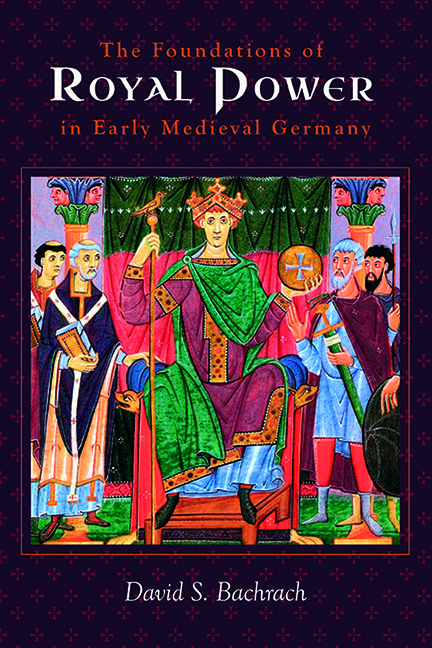 The Foundations of Royal Power in Early Medieval Germany
The Foundations of Royal Power in Early Medieval Germany Book contents
- Frontmatter
- Dedication
- Contents
- List of Illustrations
- Acknowledgments
- List of Abbreviations
- Maps
- Introduction
- 1 The Economy of Carolingian East Francia and Ottonian Germany
- 2 Material Assets of the Royal Fisc
- 3 Taxes, Tolls, and Other Regalian Rights
- 4 Ecclesiastical Resources at the Ruler’s Disposal
- 5 Toward an Analysis of Royal Expenditures: The Iter Regis and the Cost of Defense
- Conclusion
- Appendix 1 Fiscal Properties held by the Rulers of East Francia and Germany, 887–1106
- Appendix 2 Fortifications held by the Royal Government during the Reigns of Henry I and Otto I
- List of Key Terms
- List of Key Dates
- Bibliography
- Index
Appendix 1 - Fiscal Properties held by the Rulers of East Francia and Germany, 887–1106
Published online by Cambridge University Press: 16 July 2022
- Frontmatter
- Dedication
- Contents
- List of Illustrations
- Acknowledgments
- List of Abbreviations
- Maps
- Introduction
- 1 The Economy of Carolingian East Francia and Ottonian Germany
- 2 Material Assets of the Royal Fisc
- 3 Taxes, Tolls, and Other Regalian Rights
- 4 Ecclesiastical Resources at the Ruler’s Disposal
- 5 Toward an Analysis of Royal Expenditures: The Iter Regis and the Cost of Defense
- Conclusion
- Appendix 1 Fiscal Properties held by the Rulers of East Francia and Germany, 887–1106
- Appendix 2 Fortifications held by the Royal Government during the Reigns of Henry I and Otto I
- List of Key Terms
- List of Key Dates
- Bibliography
- Index
Summary
The following appendix offers evidence for the size of the imperial fisc in the period 887–1106. These data appear in graph form in chapter two (Graph 1). This appendix is divided into eight sections, numbered 1.1–1.8, which correspond to the reigns of the five Ottonian rulers (919–1024) as well as their predecessor, Arnulf of Carinthia (887–899), and two kings of the Salian dynasty, Henry III and Henry IV. The charter evidence for King Conrad II (1024–1039) is less forthcoming with regard to the possessions of the royal fisc than is the case for his predecessors and successors, and consequently is not included here, and the charters for King Henry V (1106–1125) have not been edited completely.
Each section is divided into two sub-sections. The first deals with entire estates known to be in the possession of the royal fisc, which consisted of one or more villae. For the purposes of this study, monasteries and the fiscal districts associated with specific fortresses are included in this section. These fiscal units are listed only once for each reign although most, if not all, of them comprised several if not dozens of villae. The second part of each section deals with fiscal units that are identified in the sources simply as a place (locus), property (praedia), or by name without any further specification. It is likely that many of the fiscal units listed in the second sub-section were, in fact, villae (that is, large and complex estates). I have, however, chosen to list them separately in order to provide a conservative estimate of the overall wealth of the imperial government in this period. At the head of each sub-section I give the aggregate total of fiscal properties for that reign.
Presentation of the Sources
As discussed in chapter two, the evidence for the possession of fiscal properties is drawn primarily from editions of royal charters published in the Monumenta Germaniae Historica (MGH) series. The numeral before the parentheses (given in the form “§1”) indicates the number assigned to the royal charter by the editor of the relevant volume of the MGH series. The numeral enclosed within parentheses is the number of unique fiscal properties that are identified in a particular charter.
- Type
- Chapter
- Information
- The Foundations of Royal Power in Early Medieval GermanyMaterial Resources and Governmental Administration in a Carolingian Successor State, pp. 279 - 292Publisher: Boydell & BrewerPrint publication year: 2022


